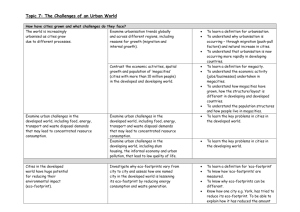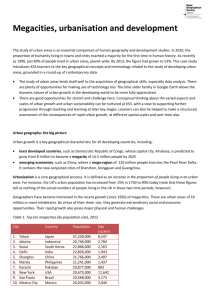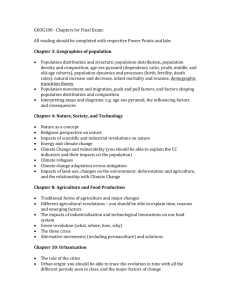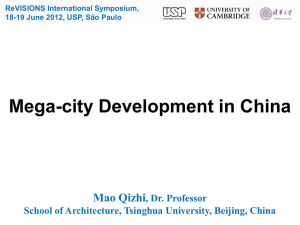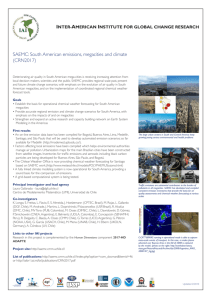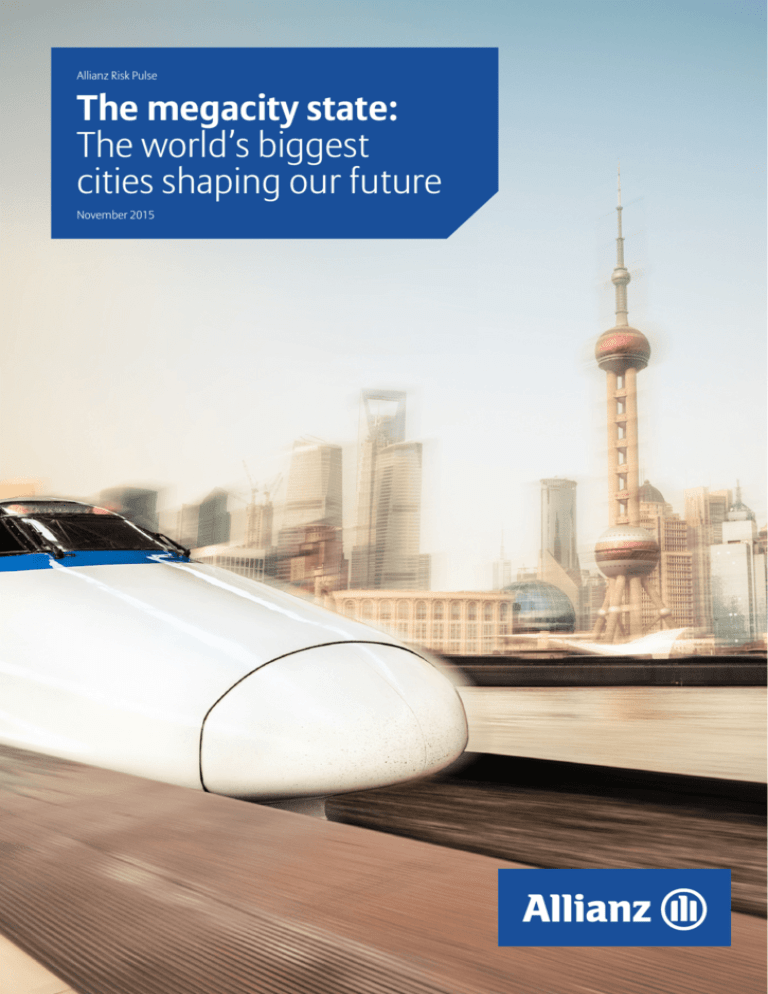
Allianz Risk Pulse
The megacity state:
The world’s biggest
cities shaping our future
November 2015
THE MEGACITY
STATE:
THE WORLD’S
BIGGEST CITIES
SHAPING OUR
FUTURE
November 30, 2030, late autumn morning: Who
hasn’t wondered how life will be in the future. Imagine
you live in a modern megalopolis, with millions of
other people? What would have changed from today?
Often it is the small, mundane things that ultimately
make the biggest difference. Let’s fast-forward to the
year 2030. Whereas, in the past, after getting up you
may have only checked e-mails and posts on your
smartphone, now you also take a quick glance at a wall
monitor. It tells you: Apartment battery 80% charged.
The solar panels and algae bioreactors that cover your
tower block are working well. There is plenty of water
too, captured during last night’s rainstorm. You notice
the view has improved since the green roof law came
in. Which reminds you: the vegetables in the highrise across the road are ready to collect. Gone are the
days when fruit and vegetables were grown only in
the countryside – now, crop fields stretch over several
stories in so-called vertical farms.
1
It is a beautiful sunny morning. However, air pollution
is particularly high on days like this so the smart traffic
management system has restricted private vehicles. No
matter, cycling to the station is good exercise. Before
you set off, you empty your garbage: food waste into the
composting tube, the rest into the tube for the district
power plant.
Outside, you cycle past the driverless cars reserved for senior
citizens – these days 15% of the world’s population is older
than 60.1 On your way to the next local transport stop, you
take a route that is lined in its entirety by solar panels. You
then pass a construction site where entire apartment blocks
are created using 3D printers. When you reach the railway
station, you decide to take the express bus. Although the
magnetic levitation train you initially wanted to take is even
faster, it is totally packed today. While the bus is racing past
endless traffic jams, you relax into your seat to prepare for
the day ahead in the megacity.
UN, 2014. Population Facts No. 2014/4 – Population ageing and sustainable development www.un.org/en/development/desa/population/publications/pdf/popfacts/PopFacts_2014-4.pdf
2
THE MEGACITY
STATE:
THE WORLD’S
BIGGEST CITIES
SHAPING OUR
FUTURE
From cities to megacities to gigacities
More than half of the world’s population already lives in
cities today.2 And the urbanization trend continues: in
2030, it will be two-thirds. Most of these urban areas
will be located in the developed countries of Northern
America (82 % of total population), Latin America and
the Caribbean (80 %) as well as Europe (73 %). While vast
parts of Africa and Asia are still mostly rural, their cities
are among the fastest growing in the world.
An increasing number of urban areas are exceeding
10 million inhabitants. We call them megacities.
Urbanisation is progressing ever faster. A new category
of urban agglomeration has emerged: gigacities. These
would be supercities of more than 50 million inhabitants,
an almost unimaginable number. And yet gigacities may
soon become reality in China. The Chinese government
is reportedly planning to connect multiple cities in five
integrated urban conurbations which would together be
home to half a billion people by 2020.3 If these ambitious
plans are realized, there will be four urban areas in China
each with more inhabitants than the whole of Germany.
Greater Shanghai could in theory contain more than 170
million inhabitants by 2020.
This extreme concentration of people is causing big
challenges, particularly in the area of sustainable
development.4 According to the UN, the world’s cities
only cover 2 % of global land area, but they account for
70 % of greenhouse-gas emissions.5 How do we find the
right balance between growth, quality of life and climate
protection? What does a city of the future have to look
like in order to make life worth living in it? There’s not a
one-size-fits-all answer to it, but many smart ideas and
approaches to the most pressing challenges in the field
of demography and mobility. This ‘Allianz Risk Pulse’ is
taking a closer look at them.
Why megacities matter
“The course of how we will live in the future is being set in
these megalopolises. This is where tomorrow’s trends are
emerging,” predicts Allianz SE Board Member Axel Theis.
“The megalopolises show where urban development
is headed – and how transport, energy, culture, and
economies can be organized. Allianz will play a key role
in urban development as we accompany our customers
in the megacities. Their changing living conditions will
create new needs which we as an insurer will have to be
able to serve. With knowledge comes the responsibility
to act, especially when it comes to managing risks such
as natural catastrophes or climate change, and protecting
and investing in critical infrastructure.”
The challenges are huge – and so are the dimensions:
In 1950, there were just two of these conurbations of
at least 10 million people, New York and Tokyo. In 2015,
there are 29, 16 of them in Asia. By 2030, there will
be 41 (see Figure 1).
Megacities punch above their weight. In 2010, 6.7% of
the global population lived in these cities. Their thirst
for energy, measured in terms of global consumption,
was just as high. They used 3% of global freshwater6
and generated 14.6% of global GDP. The most powerful
megacities – New York, London, Tokyo and Paris – have
bigger economies than most other countries. New
UN, 2014. World Urbanization Prospects. Highlights
www.welt.de/wirtschaft/article139351977/Mega-City-China-baut-schon-an-Giga-Staedten.html
4
UN, 2014. World Urbanization Prospects. Highlights
5
UN HABITAT, 2011. Hot Cities: battle ground for climate change
6
Kennedy, Christopher A. et al., 2015. Energy and material flows of megacities. Proceedings of the National Academy of Sciences, vol. 112, no.19. www.pnas.org/content/112/19/5985.abstract
2
3
3
THE MEGACITY
STATE:
THE WORLD’S
BIGGEST CITIES
SHAPING OUR
FUTURE
York generates $1.4 trillion in total economic output,
London $836 billion.7 According to the OECD, it is
only a matter of time before the economic strength
of numerous urban agglomerations is greater than
that of most OECD countries.8 Megacities concentrate
opportunities, talent and investment. A large portion of
the estimated $100 trillion assets under management
by 2020 is likely to be traded in the growth regions.
“We expect further asset growth to particularly take
place in Asia,” says Jay Ralph, Member of the Board of
Management of Allianz SE. “By the end of 2014, 11% of
our overall third party assets came from clients in this
region. We already benefit from an increasing demand
by a growing number of wealthy clients. Estimates by
the OECD indicate that 1.75 billion people in Asia will be
defined as ‘middle-class’ by 2020, today it is 500 million.
An increasing demand for retirement products will be
another growth trigger as Asian societies are aging fast.”
Apart from the opportunities, megacities also concentrate
risks. “Development of these cities will not only require
huge investments in infrastructures,” notes Axel
Theis. “The value concentration in megacities also
results in accumulation risks which tend to be heavily
interdependent, especially when you think of business
interruption scenarios. This poses a major challenge for
insurers, particularly in natural catastrophe-prone areas.”
Most megacities are indeed low-lying coastal settlements
vulnerable to extreme weather and climate change impacts
(see Box Megacities exposed to flood risks, p.10).
Figure 1 Selected current and future megacities 2015 to 2030
Moscow, Russia
12.1m 12.2m
Los Angeles, US
12.3m 13.2m
New York, US
18.5m 19.8m
Karachi, Pakistan
16.6m 24.8m
Paris, France
10.8m 11.8m
Cairo, Egypt
18.7m 24.5m
Bogotá, Colombia
9.7m 11.9m
Lagos, Nigeria
13.1m 24.2m
Mexico City, Mexico
21m 23.8m
KEY
Current megacities
Sao Paulo, Brazil
21m 23.4m
Luanda, Angola
5.5m 10.4m
Bangkok, Thailand
9.2m 11.5m
Ahmedabad, India
7.3m 10.5m
Mumbai, India
21m 27.8m
Kinshasa, Congo
11.5m 20m
Rio de Janeiro, Brazil
12.9m 14.1m
Future megacities
2015 population
Beijing, China
20.3m 27.7m
Chengdu, China
7.6m 10.1m
Lahore, Pakistan
8.7m 13m
Ho Chi Minh City, Vietnam
7.3m 10.2m
Tokyo, Japan
38m 37.1m
Shanghai, China
23.7m 30.7m
Manila, Philippines
12.9m 16.7m
Hyderabad, India
8.9m 12.7m
2015 population
2030 population
Chongqing, China
13.3m 17.3m
Dehli, India
25.7m 36m
London, UK
10.3m 11.4m
Johannesburg, South Africa
9.7m 11.9m
Jakarta, Indonesia
10.3m 13.8m
Buenos Aires, Argentina
15.1m 16.9m
2030 population
Source: World Urbanization Prospects: The 2014 Revision
Citylab.com, 2015. Sorry, London: New York Is the World’s Most Economically Powerful City www.citylab.com/work/2015/03/sorry-london-new-york-is-the-worlds-most-economicallypowerful-city/386315/
8
OECD, 2015. The Metropolitan Century: Understanding Urbanisation and its Consequences www.oecd.org/regional/regional-policy/the-metropolitan-century-9789264228733-en.htm
7
4
THE MEGACITY
STATE:
THE WORLD’S
BIGGEST CITIES
SHAPING OUR
FUTURE
Megacity growth patterns
More than 12% of global city dwellers live in the 29
megacities existing in 2015. That is more than 470
million people.9 Tokyo (38 million), Delhi (25.7 million)
and Shanghai (23.7 million) are the largest ones.
They will remain so up to 2030, by which time 12
new megacities will have emerged, 10 of them in
Asia or Africa. Delhi, Dhaka, and Lagos will each have
added around 10 million inhabitants – the equivalent
of another megacity. African and Asian megacities are
the fastest growing metropolises: Delhi, Dhaka and
Lagos will grow by 10 million inhabitants each. “Right
now, the growth of megacities is largely an Asian
phenomenon, with six of the 10 most populous cities
located in the region,” adds Ralph.
By contrast, Japanese, American and European megacities
are barely growing at all. By 2030, Tokyo and Osaka will be
smaller than today. London, Paris and New York will have
added just one million citizens each (see Figure 2).
All megacities face the twin global pattern of declining
household size and growing numbers of households.
These propel demand for housing and infrastructure.
The strongest growth in housing demand to 2025 will
be in Beijing, Shanghai, and Tokyo.10 The Chinese high
tech company Yingchuang New Materials counters
the threatening housing shortage with a particularly
innovative solution: 3D-printed houses using recycled
construction waste.11
Figure 2 Past and future growth of Top 10 megacities, plus Paris and London
40m
1. Tokyo
2. Dehli
35m
3. Shanghai
30m
4. Sao Paulo
5. Mumbai
Population
25m
6. Mexico City
20m
7. Beijing
15m
8. Osaka
9. Cairo
10m
10. New York-Newark
5m
25. Paris
0m
1950
1960
1970
1980
1990
2000
2010
2015
2020
2030
28. London
Year
Source: United Nations Population Division: World Urbanization Prospects, the 2014 revision
United Nations Population Division, 2014. World Urbanization Prospects, the 2014 revision
McKinsey Global Institute, 2011. Urban world: Mapping the economic power of cities www.mckinsey.com/insights/urbanization/urban_world
11
Computerworld, 2014. 3D printer constructs 10 buildings in one day from recycled materials www.computerworld.com/article/2489664/emerging-technology/3d-printer-constructs-10buildings-in-one-day-from-recycled-materials.html
9
10
5
THE MEGACITY
STATE:
THE WORLD’S
BIGGEST CITIES
SHAPING OUR
FUTURE
DRONE DELIVERY
Courier service for
small packages
GREEN ROOFS
Absorb heat, filter air
pollutants and CO2.
Rainwater harvested can
be used for toilet flushing
FARMSCRAPER
SOLAR FILM ON
BUILDING FRONT
Farmscrapers
reduce land, wate
and energy requir
for food productio
Generate electricity
stored in batteries
STORM WATER
DRAINAGE
Reduce runoff and
flood risk. Rainwater
harvested can be
used for farming
SMART ELE
ELEVATED
PEDESTRIAN PARK
Stores, mana
energy from
and waste so
Routes connect
infrastructure avoiding
traffic and road
crossings, enhancing
walkability
UNDERGROUND FARM
Hydroponic, pesticide-free,
water-efficient farming
using low-energy LED lights
UNDERWATER
TURBINES
Tidal turbines in
river feed smart grid
Megacity solutions
Megacities must adapt and innovate to meet the challenges residents face. Here are some
solutions that could make megacities greener, more efficient and more pleasant places to live.
ALGAE ENERGY FARM
Building panels absorb
CO2 to grow algae that is
fermented to produce biogas
WASTE-TO-POWER PLANT
Incinerators turn garbage into
power fed into local smart grid
RS
ELECTRIC CAR
CHARGING POINTS
er
red
on
WASTE DISPOSAL TUBES
Pneumatic pipes suck garbage
from homes and offices to
recycling stations and
incinerators
e-vehicle charging
points powered by the
smart grid
3D PRINTED HOMES
ECTRICITY GRID
Affordable houses built
by giant 3D printers using
recycled construction
waste as building material
ages and distributes
solar, algae, hydro
ources
WIRELESS DRIVERLESS
CARS & BUSES
Vehicles charged wirelessly
through streets connected
to smart grid
CYCLE SHARING SCHEME
Bike-sharing bays beside subway/
railway station and at edge of the city
TRAFFIC & POLLUTION SENSORS
Continuously send data to a city traffic
management system. Mounted on buses,
streetlights and other infrastructure
BARRIER-FREE
INFRASTRUCTURE
Escalators, elevators
and walkways cater for
aging populations
MAGLEV SUBWAY
High-speed system
uses magnets to
levitate and propel
subway cars
6
THE MEGACITY
STATE:
THE WORLD’S
BIGGEST CITIES
SHAPING OUR
FUTURE
Living longer and poorer?
The age structure varies enormously between megacities
(see Appendix on page 12). Many societies are aging
rapidly. When the population of a country is aging on
average, clearly also the inhabitants of cities are aging.
However, this trend cannot be translated at a ratio of 1:1
to the demographic development of megacities. After
all, the way the population of a specific country evolves
results in different age structures. However, since the
people moving to urban areas are generally young, cities
are aging more slowly than the country they are located
in and again much more slowly than rural areas.
In this context, one also has to keep in mind that the
challenges arising from an aging population might be
easier to address within cities, as there is already an
existing infrastructure which is relevant for the elderly,
i.e. hospitals, care facilities, social logistics. Construction
projects can often be realized more easily in major cities
than in the countryside. For example, compared with
rural areas, it is easier and less expensive to equip urban
centers with sidewalks adapted to the needs of aging
citizens.
In China’s megacities, at least 80% of residents were of
working age in 2010, with relatively few children, last but
not least because of the country’s one child policy. Right
now, these cities’ key challenge is providing sufficient
jobs and housing for workers. There is a real risk that
the development of prosperity and affluence may not
be able to keep pace with the demographic evolution.
Poverty looms. The lack of children might mean they
have far fewer workers to propel economic growth and
support care of the elderly over the long run.
“In China, the number of people aged over 60 is
projected to exceed the entire US population by 2035,”
says Jay Ralph. Shanghai is expected to be home to
twice as many elderly people as New York in 2025.12
12
13
For the financial provision of the elderly this means: As
Asian societies are aging rapidly and life expectancy is
increasing at the same time, people will increasingly
have to tap into their savings to pay for care or housing.
A longer life expectancy means more time spent in
retirement for which people have to save.
Birth rates in India have declined as well. At 1.8 children
per woman, birth rates have fallen far below replacement
level.13 However, India’s large urban agglomerations
currently have much larger proportions of children (25%
in Delhi and 22% in Mumbai) than China’s megacities
and so in the next two to three decades they will have
the demographic dividend of large cohorts of working
age people relative to dependent seniors and children. In
2025, 72% of Delhi residents will be working age and just
9% over 65 years old.
In Asian and African megacities, children younger
than 15 years make up at least a quarter of the
population. In these places, basic sanitation, energy,
healthcare, education and transport services will be
critical to enable young people to become productive
citizens and thereby allow societies to fully exploit their
demographic dividend.
In Tokyo and Osaka, the Japanese megacities, the situation
is completely different. One in five residents is aged 65
or over. These cities will have to adapt streets, sidewalks,
transport services and road crossings for the elderly.
The concept of accessibility will take on a whole new
meaning then. Vital services must be close to transport
hubs. Taxation and social security systems also face drastic
reforms as the falling working-age population has to fund
a rising number of retirees. The aging process affects all
areas of society, even those pop culture segments that
used to be a stronghold of youth: already today, there are
bands with over 90 year old artists.
McKinsey Global Institute, 2011. Urban world: Mapping the economic power of cities www.mckinsey.com/insights/urbanization/urban_world
James, K.S. & Kavitha, N., 2015. View from a fast-growing nation: What demographic change means for India, in ‘Our World and Us: How our environment and our societies will change’, Allianz SE.
7
THE MEGACITY
STATE:
THE WORLD’S
BIGGEST CITIES
SHAPING OUR
FUTURE
Three development stages of megacities
Many megacities undergo different phases of life,
similar to human beings. Others experience stagnation.
Megacities can be roughly categorized as low, medium
or high maturity. “There are major differences between
mature and developing megacities (see Figure),14”
observes Tina Baacke, Global Head of Catastrophe
Risk Management, Allianz Global Corporate & Specialty
(AGCS). “These include building standards, disaster
preparedness and maintenance of vital infrastructure
systems.”
Low maturity megacities such as Dhaka,
Kinshasa and Lagos are fast-growing and youthful
with many unplanned slums, minimal building
standards and large informal economies. These
cities are characterized by enormous inequalities,
relatively weak administrations, fragmented public
transport, congestion and a shortage of basic
services.
Dhaka
Maturity Level
Characteristics
Challenges & Risks
Medium maturity megacities like Shanghai, Sao Paulo
and Mexico City are growing at markedly slower rates
and are beginning to age. They are richer and bettergoverned than low-maturity megacities but do not
necessarily boast superior infrastructure and urban
planning. Unbridled traffic is one of the main problems
as more and more people can afford a car, resulting in
congestion, chaos and air pollution.
High maturity megacities like Tokyo, New York,
London and Paris have aging populations and
infrastructure in need of modernization. Their
key strength is their wealth. These cities have the
means to invest in innovative solutions. The Thames
Barrier protecting London from flooding is a notable
example. The public transportation system is highly
developed, but may be in need of upgrading. Rising
living costs are expanding gaps between rich and
poor, leading to social exclusion and segregation.
Shanghai
London
Low
Medium
High
Examples:
Dhaka, Kinshasa, Lagos
Examples:
Shanghai, Mexico City, Rio de Janeiro
Examples:
London, New York, Tokyo
High growth rate
Continuing growth
Flat or negative growth
Young population
Signs of aging population
Aging population
Unplanned slums
Urban planning evident
Coordinated urban planning
Limited mass transit
Expanded mass transit
Embedded mass transit
Fragmented governance
Coordinated governance
Centralized governance
Weak energy, health, education
infrastructure
Improved energy, health, education
infrastructure
Established energy, health, education
infrastructure
Extreme poverty
Pockets of poverty
Widening inequalities
Extreme social segregation
Chronic social segregation
Inadequate housing
Aging infrastructure requiring low-carbon,
smart alternatives
Transport congestion
Unequal access to basic services &
infrastructure
Chronic air, water pollution
Inefficient urban sprawl
Aging mass transit requiring upgrading,
expansion
Poor health outcomes
Chronic air pollution & congestion
Air pollution requiring traffic controls
Low education & skills
Vulnerable to natural & climate-related
disasters
Energy- inefficient housing
Weak governance, corruption & crime
Value concentration risks
High disaster risk
Adapted from: Ericsson. 2013. p.4. The next age of megacities www.ericsson.com/res/docs/2013/the-next-age-of-megacities.pdf
UN Habitat report – The city we need mirror.unhabitat.org/downloads/docs/The%20City%20We%20Need.pdf
14
Ericsson, 2012. The Three Ages of Megacities www.ericsson.com/res/docs/2012/ns_megacities_report_4.pdf
8
THE MEGACITY
STATE:
THE WORLD’S
BIGGEST CITIES
SHAPING OUR
FUTURE
Mobility in megacities: short distances are the key
Due to the urbanization of the world’s population, which
in some cases is occurring at rapid speed, politicians, city
planners and transport developers are facing unknown
challenges.
For many academics, the key for the city of the future
lies in its compactness. They likewise warn against
de-urbanization. This term is used by experts to refer to
vast settlements without links to public transport, the
conventional suburbs in Western countries, or totally
vacant pockets of land in China’s new towns.
“Building better connected, more compact cities based
on mass public transport can save over $3 trillion
in investment costs over the next 15 years. These
measures will improve economic performance and
reduce emissions, raising the quality of life.” This was
the conclusion reached by the authors of the latest New
Climate Economy Report.15
“The ideal city is one that consists of multiple selfcontained centers,” says climate expert Thomas Liesch
from Allianz Climate Solutions. He is a fan of short
distances. His idea is that “in the city of the future, people
would work and live in their respective districts, thus
saving a great deal of time and energy, and reducing
traffic density. Fewer cars would mean more space for
pedestrians, while a network of green spaces would
connect the individual neighborhoods. Not only would this
improve the climate, but it would also allow more space
for leisure activities and food production.”
Although it doesn’t count as a megacity, many experts
consider Singapore to be a prime example of the ideal city,
also in terms of compactness. The Interlace project saw
the creation of a vertical village in the city: apartment
blocks were stacked on top of one another rather than
being built side-by-side, with roof gardens, playgrounds
and courtyards included in the development.
In other locations, projects such as the High Line Park in
New York, the congestion charge in London, or the public
rental system for electric cars in Paris, seem to suggest that
the human race is slowly getting to grips with the traffic
issue, and increasingly using the reclaimed living space for
its own well-being.
Nevertheless, in most megacities the reality looks quite
different. Ho Chi Minh City is one example. Roughly 7.3
million people currently live in the largest city in Vietnam.
According to UN estimations, by 2030 this figure will reach
more than 10.2 million (see diagram on page 3). That’s
roughly the same as the population of London today.
The British capital is home to the third longest subway
system in the world, with a total length of 400 kilometers.
In Ho Chi Minh City, on the other hand, the subway is only
just being built. The first two lines are planned to go into
operation in 2018.
Above: High Line Park in New York
Left: Singapore roof garden
15
Source: newclimateeconomy.net/content/press-release-economic-growth-and-action-climate-change-can-now-be-achieved-together-finds
9
THE MEGACITY
STATE:
THE WORLD’S
BIGGEST CITIES
SHAPING OUR
FUTURE
Mexico City house
facade
Photo: elegant
embellishments/Alejandro
Cartagena
The lack of public transport is particularly striking in
emerging megacities. The consequence: total gridlock
and smog alert. In 2014, the lowest pollution load in
New Delhi was higher than the highest level in Beijing
– a city notorious for smog as it is.16 The main source of
the particulates is cars. The health hazard is enormous:
according to King’s College London, nearly 9,500 people
died in London alone in 2010 as a consequence of air
pollution – despite all of the city’s efforts to curb traffic
density.17
Other cities besides London have also picked up the
pace in the battle against particulates. In Mexico City,
for instance, a house facade that can neutralize the
particulate air pollution from 1,000 cars every day (see
image above) is currently being developed.
Traffic jams and pollution: two terms that the cars of
tomorrow will hopefully no longer be associated with.
More efficient combustion engines are designed to
give cars a cleaner image. An even easier way to cut
emissions is to leave your car at home altogether, or
start a car pool. In the long term, however, engineers are
planning to revolutionize the way we drive. Automated
cars could have taken over on the roads by 2030,
according to experts.
In theory, these automated cars could simply drop their
passengers off at their desired location and then leave
the city boundaries until they are summoned again via
an App, just like taxis. This would be a huge gain for
city residents, who are all plagued by large volumes of
traffic. “Automatic driving makes the road use more
efficient since you can squeeze more cars into a single
lane. You could save two or three lanes, which in the
end gives space for green areas and wider sidewalks.
Furthermore, electric cars would help reduce emissions
and noise levels. Once highly unpopular areas along busy
roads would regain appeal,“ says architect Jürgen Mayer,
winner of the Audi Urban Future Award 2010.18
Digital infrastructure with sensors fitted in cars and on
entire roads is supposed to make traffic jams and parking
space problems a thing of the past. According to a study
by Navigant Research, the installed base of sensorenabled on-street smart parking spaces is expected to
surpass 1 million globally by 2024.19
Alongside arterial roads, attention is also turning to
energy supply as a target for future investments. It’s
the Achilles’ heel of a city. A power outage lasting days
isn’t just a test of endurance for civilization, for social
cooperation; a blackout can bring the whole system to its
knees.
With resilience in mind, academics, politicians and
business representatives have developed the vision of a
Smart City. The nervous system of tomorrow’s intelligent
city is based on the Internet: electricity, transport, supply
and disposal systems are electronically linked. Buildings
produce their own electricity and store it in powerful
battery storage devices for example. This results in a
decentralized energy-generation and storage system,
which will also mitigate the impact of power outages if
Source: energydesk.greenpeace.org/2015/03/09/india-air-pollution-delhis-smog-still-worse-beijings/
Source: www.independent.co.uk/news/uk/home-news/nearly-9500-people-die-early-in-a-single-year-in-london-as-a-result-of-air-pollution-study-finds-10390729.html
18
Source: www.allianz.com/en/about_us/open-knowledge/topics/mobility/articles/120418-future-car-logs-onto-city-streets.html
19
Source: www.navigantresearch.com/research/smart-parking-systems
16
17
10
THE MEGACITY
STATE:
THE WORLD’S
BIGGEST CITIES
SHAPING OUR
FUTURE
push comes to shove. Traffic control systems respond
to real-time data, reduce traffic and redirect it. The
workplace and the home merge. Supply chains are
optimized.
The necessary infrastructure requires secure support.
The insurance industry’s role is to protect people,
property and systems alike – regardless of their
complexity and size. By pushing the boundaries of
insurability, the (re)insurance business can make an
effective contribution to the development of megacities.
In this way, the insurance industry is a powerful tool to
strengthen the resilience of local and national economies
and societies at large.
Megacities exposed to flood risks
According to a study by World Bank and OECD, climate change,
rapid urbanization and subsiding land are putting the world’s
coastal cities at increasing risk of dangerous and costly flooding.
The study found that the average global flood losses could rise
from $6 billion in 2005 to $1 trillion per year in 2050 if cities don’t
take steps to adapt.20 At particular risk are coastal megacities in
Southeast Asia and the eastern US. In its Revision of the World
Urbanization Prospect, which is published every two years, the
UN (2011) revealed that a total of approximately 890 million city
residents are currently exposed to natural disasters.21
Axel Theis explains that a completely new risk landscape has
developed for the insurance industry: “The frequency and
intensity of climatological events has increased on a global scale
over the last 50 years – and with it the concentration of insured
assets. At the same time infrastructure expansion cannot keep
pace with the increasing needs of the population. This imbalance
makes cities extremely vulnerable to natural disasters, especially
in Asia.” Already today, cities like Beijing, Delhi, Jakarta, Manila,
Mumbai, Shanghai and Taipei are all at risk from flooding and/or
typhoons.
In comparison to the United States, Asia is 62 times more
vulnerable to flooding, and 40 times more vulnerable to tropical
cyclones. Asia stands to lose much more in natural disasters. At
the same time, there is still a serious insurance protection gap for
natural catastrophe risks.
Catastrophes such as the flood in Bangkok in 2011 costing
$45 billion demonstrate the accumulation of risks is rising
exponentially with ‘hidden risks’ such as contingent business
interruption increasingly prevalent.
Climate change is set to further exacerbate the situation in
Asia. Unless managed appropriately – for example, through
such measures as insurance solutions as well as adaptation and
20
21
Bangkok flood in 2011
Photo: Voice of America, via Wikimedia Commons
mitigation strategies –, the potential extent of damage and the
repercussions on the population would therefore be significant
in Asia’s urban centers. And while insurance density continues to
grow thanks to greater prosperity, so do the uncertainties in the
insurance industry due to paucity of risk assessment data.
“In order to keep up with the rapid changes in risk concentration,
we’re using the most modern technology and models,” says
Theis. “For instance, by utilizing satellite technology and 3D
imaging we can assess risks precisely – down to the level of
individual buildings. But the most sophisticated mathematical
model in the world can only work if the data used is correct and
the risk is clearly identifiable. The Thailand flood was a megaoccurrence of this kind that couldn’t be modeled beforehand.
Many company premises were submerged, which led to supply
chain interruptions across the world. To be able to even better
assess risks in the future, technological advances such as
geocoding but also an ongoing direct dialogue with the customer
are fundamental.”
Source: www.worldbank.org/en/news/feature/2013/08/19/coastal-cities-at-highest-risk-floods
Source: www.un.org/en/development/desa/publications/world-urbanization-prospects-the-2011-revision.html
11
THE MEGACITY
STATE:
THE WORLD’S
BIGGEST CITIES
SHAPING OUR
FUTURE
The World’s Megacities: Population Highlights
Megacity
Country
2010 population age
distribution (%)
2015
population in
millions
2030
population in
millions
2030
population
growth
0-14
15-64
65+
2010 population
density per km2
2015-2020 average
annual population
growth rate (%)
Tokyo
Japan
38.00
37.19
(- 0.81)
12
69
19
4,400
0.17
Delhi
India
25.70
36.06
(10.36)
25
71
4
12,100
2.65
Shanghai
China
23.74
30.75
(7.01)
9
80
11
6,100
2.67
São Paulo
Brazil
21.07
23.44
(2.37)
22
71
7
7,500
0.98
Mumbai
India
21.04
27.80
(6.76)
22
72
6
32,400
1.64
Mexico City
Mexico
21.00
23.86
(2.86)
25
68
7
9,700
0.81
Beijing
China
20.38
27.71
(7.33)
9
80
11
5,500
3.43
Osaka
Japan
20.24
19.98
(-0.26)
13
67
20
5,400
0.28
Cairo
Egypt
18.77
24.50
(5.73)
26
69
5
8,900
1.83
New York-Newark
US
18.59
19.89
(1.3)
19
68
13
1,800
0.21
Dhaka
Bangladesh
17.60
27.37
(9.77)
30
65
5
43,500
3.52
Karachi
Pakistan
16.62
24.84
(8.22)
37
60
3
23,400
2.92
Buenos Aires
Argentina
15.18
16.96
(1.78)
23
65
12
5,300
0.92
Kolkata
India
14.86
19.09
(4.23)
26
69
5
12,200
1.13
Istanbul
Turkey
14.16
16.69
(2.53)
24
70
6
9,800
1.28
Chongqing
China
13.33
17.38
(4.05)
15
72
13
7,700
2.67
Lagos
Nigeria
13.12
24.24
(11.12)
32
65
3
14,500
4.17
Manila
Philippines
12.95
16.76
(3.81)
31
66
3
15,300
1.48
Rio de Janeiro
Brazil
12.90
14.17
(1.27)
21
70
9
5,800
0.65
Guangzhou
China
12.46
17.57
(5.11)
11
82
7
6,000
3.94
Los Angeles
US
12.31
13.26
(0.95)
21
68
11
2,400
0.23
Moscow
Russia
12.17
12.20
(0.03)
12
74
14
3,500
0.50
Kinshasa
DRC
11.59
20.00
(8.41)
46
51
3
19,900
3.95
Tianjin
China
11.21
14.66
(3.45)
11
78
11
5,400
2.68
Paris
France
10.84
11.80
(0.96)
20
68
12
3,800
0.77
Shenzhen
China
10.75
12.67
(1.92)
8
91
1
6,900
0.98
Jakarta
Indonesia
10.32
13.81
(3.49)
24
73
3
9,500
1.81
London
UK
10.31
11.46
(1.15)
18
68
14
5,900
1.01
Bangalore
India
10,09
14.76
(4.67)
23
73
4
8,400
3.20
Sources:
United Nations Population Division: World Urbanization Prospects, the 2014 revision esa.un.org/unpd/wup/CD-ROM/
Age distribution: McKinsey Global Institute, Urban World v.1.1 mobile app www.mckinsey.com/insights/mgi/in_the_news/urban_world_app
Population density: Demographia World Urban Areas, 11th Annual Edition, 2015 demographia.com/db-worldua.pdf
CONTACTS
Bettina Sattler
Group Communications
Allianz SE
bettina.sattler@allianz.com
Petra Brandes
Group Communications
Allianz SE
petra.brandes@allianz.com
These assessments are, as always, subject to the disclaimer provided below.
Editor: Michael Grimm, James Tulloch
Contributor: Celina Hackmann
Design: Kapusniak Design
Website: www.allianz.com
Twitter:
@Allianz
Photos: Shutterstock/Adobe Stock
Copyright © 2015 Allianz SE. All rights
reserved.
Cautionary note regarding forward-looking statements
The statements contained herein may include prospects, statements of future expectations and other forward-looking statements that are based
on management‘s current views and assumptions and involve known and unknown risks and uncertainties. Actual results, performance or events
may differ materially from those expressed or implied in such forward-looking statements. Such deviations may arise due to, without limitation,
(i) changes of the general economic conditions and competitive situation, particularly in the Allianz Group‘s core business and core markets, (ii)
performance of financial markets (particularly market volatility, liquidity and credit events), (iii) frequency and severity of insured loss events,
including from natural catastrophes, and the development of loss expenses, (iv) mortality and morbidity levels and trends, (v) persistency levels,
(vi) particularly in the banking business, the extent of credit defaults, (vii) interest rate levels, (viii) currency exchange rates including the euro/
US-dollar exchange rate, (ix) changes in laws and regulations, including tax regulations, (x) the impact of acquisitions, including related integration
issues, and reorganization measures, and (xi) general competitive factors, in each case on a local, regional, national and/or global basis. Many of
these factors may be more likely to occur, or more pronounced, as a result of terrorist activities and their consequences.
No duty to update
The company assumes no obligation to update any information or forward-looking statement contained herein, save for any information
required to be disclosed by law.
Publisher:
Allianz SE, Königinstraße 28, 80802 Munich, Germany
12



